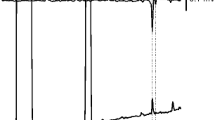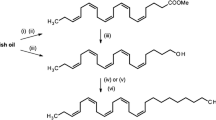Abstract
Heliothis subflexa males were flown in a wind tunnel to a variety of combinations of synthetic pheromone components admixed on a filter paper disk. Blends containing (Z)-11-hexadecenal (Z11–16:Ald, 1000 ng), (Z)-9-hexadecenal (Z9–16:Ald, 500 ng) and (Z)-11-hexadecenol (Z11–16:OH, 10–500 ng) elicited upwind flight and source contact in 52–69% of males. All these compounds have previously been isolated and identified from female H. subflexa gland extracts and volatile pheromone emissions. Males were not attracted by blends in which Z9–16:Ald was omitted (0% source contact). Similarly, blends lacking Z11–16:OH were unattractive to male H. subflexa (3% or less source contact). Males were extremely sensitive to the presence of Z11–16:OH; however, responding in high numbers (57–69% source contact) to blends containing a dosage of 1% (10 ng) or greater Z11–16:OH. Males were unresponsive to blends in which Z9–16:Ald was replaced with a variety of dosages of (Z)-9-tetradecenal, a secondary component of a closely-related congeneric species, Heliothis virescens. Another compound present in the blend emitted by conspecific females, (Z)-11-hexadecenyl acetate (Z11–16:Ac), did not inhibit H. subflexa males (69% source contact) when added to the three-component mixture (1:0.5:0.1) at a ratio of 0.1 (100 ng) with respect to Z11–16:Ald. These results indicate that Z9–16:Ald and Z11–16:OH are required in addition to Z11–16:Ald to elicit significant levels of upwind flight in H. subflexa males. The effects of Z11–16:Ac are more subtle, but at the dosage tested in these experiments, this compound does not have an antagonistic effect on upwind flight and source location by H. subflexa males.
Similar content being viewed by others
REFERENCES
Cho, S., Mitchell, A., Regier, J. C., Mitter, C., Poole, R. W., Friedlander, T. P., and Zhao, S. 1995. A highly conserved nuclear gene for low-level phylogenetics: Elongation factor-1 alpha recovers morphology-based tree for heliothine moths. Mol. Biol. Evol. 12:650–656.
Fadamiro, H. Y., Coss, A. A., and Baker, T. C. 1999. Fine-scale resolution of finely spaced pheromone and antagonist filaments by flying male Helicoverpa zea. J. Comp. Physiol. A 185:131–141.
Fang, Q. Q., Cho, S., Regier, J. C., Mitter, C., Matthews, M., Poole, R. W., Friedlander, T. P., and Zhao, S. 1997. A new nuclear gene for insect phylogenetics: DOPA decarboxylase is informative of relationships wihtin Heliothinae (Lepidoptera: Noctuidae). Syst. Biol. 46:269–283.
Heath, R. R., Teal, P. E. A., Tumlinson, J. H., and Mengelkoch, L. J. 1986. Prediction of release ratios of multicomponent pheromones from rubber septa. J. Chem. Ecol. 12:2133–2143.
Heath, R. R., Mitchell, E. R., and Cibrian-Tovar, J. 1990. Effect of release rate and ratio of (Z)-11-hexadecen-1-ol from synthetic pheromone blends on trap capture of Heliothis subflexa (Lepidoptera: Noctuidae). J. Chem. Ecol. 16:1259–1268.
Heath, R. R., McLaughlin, J. R., Proshold, R., and teal, P. E. A. 1991. Periodicity of female sex pheromone titer and release in Heliothis subflexa and H. virescens (Lepidoptera: Noctuidae).Ann. Entomol. Soci. Ame. 84:182–189.
Klun, J. A., Plimmer, J. R., and Bierl-Leonhardt, B. A. 1979. Trace chemicals: The essence of sexual communication systems in Heliothis species. Science 204:1328–1330.
Klun, J. A., Bierl-Leonhardt, B. A., Plimmer, J. R., Sparks, A. N., Primiani, M., Chapman, O. L., Lepone, G., and Lee, G. H. 1980a.Sex pheromone chemistry of the female tobacco budworm moth, Heliothis virescens. J. Chem. Ecol. 6:177–183.
Klun, J. A., Plimmer, J. R., Bierl-Leonhardt, B. A., Sparks, A. N., Primiani, M., Chapman, O. L., Lee, G. H., and Lepone, G. 1980b. Sex pheromone chemistry of female corn earworm moth, Heliothis zea. J. Chem. Ecol. 6:6165–175.
Klun, J. A., Leonhardt, B. A., Lopez, J. D., Jr., and Lachance, L. E. 1982. Female Heliothis sub-flexa (Lepidoptera: Noctuidae) sex pheromone: Chemistry and congeneric comparisons. Environ. Entomol. 11:1084–1090.
Laster, M. L. 1972. Interspecific hybridization of Heliothis virescens and H. subflexa. Environ. Entomol. 1:682–687.
cMitter, C., Poole, R.W., and Matthews, M. 1993. Biosystematics of the Heliothinae (Lepidoptera:Noctuidae). Annu. Rev. Entomol. 38:207–225.
Pope, M. M., Gaston, L. K., and Baker, T. C. 1982. Composition, quantification, and periodicity of sex pheromone gland volatiles from individual Heliothis virescens females. J. Chem. Ecol. 8:1043–1055.
Pope, M. M., Gaston, L. K., and Baker, T. C. 1984. Composition, quantification, and periodicity of sex pheromone volatiles from individual Heliothis zea females. J. Insect Physiol. 30:943–945.
Proshold, F. I., Martin, D. F., Laster, M. L., Raulston, J. R., and Sparks, A. N. 1983. Release of backcross insects on St. Croix to suppress the tobacco budworm (Lepidoptera: Noctuidae): methodology and dispersal of insects. J. Econ. Entomol. 76:885–891.
Quero, C. and Baker, T. C. 1999. Antagonistic effect of (Z)-11-Hexadecen-1-ol on the pheromonemediated flight of Helicoverpa zea (Boddie) (Lepidoptera:Noctuidae). J. Insect Behav. 12:701– 710.
Ramaswamy, S. B., Randle, S. A., and Ma, W. K. 1985. Field evaluation of the sex pheromone components of Heliothis virescens (Lepidoptera: Noctuidae) in cone traps. Environ. Entomol. 14:293–296.
Roelofs, W. L., Hill, A. S., CardÉ, R. T., and Baker, T. C. 1974. Two sex pheromone components of the tobacco budworm moth, Heliothis virescens. Life Sci. 14:1555–1562.
Sparks, A. N., Raulston, J. R., Lingren, P. D., Carpenter, J. E., Klun, J. A., and Mullinix, B. G. 1979. Field response of male Heliothis virescens to pheromonal stimuli and traps. ESA Bull. 2:268–274.
Steel, R. G. D. and Torrie, J. H. 1961. Principles and Procedures of Statistics, McGraw-Hill, New York.
Teal, P. E. A. and Tumlinson, J. H. 1986. Terminal steps in pheromone biosynthesis by Heliothis virescens and H. zea. J. Chem. Ecol. 12:353–366.
Teal, P. E. A. and Tumlinson, J.H. 1987. Induced changes in sex pheromone biosynthesis of Heliothis moths (Lepidoptera: Noctuidae), pp. 79–94, in J. H. LAW (ed.). Molecular Entomology. Alan R. Liss, New York.
Teal, P. E. A. and Tumlinson, J. H. 1997. Effects of interspecific hybridization between Heliothis virescens and H. subflexa (Lepidoptera: Noctuidae) on the sex pheromone communication system, pp. 535–547, in R. T. Cardé and A. K. Minks, (eds.). Insect Pheromone Research: New Directions. Chapman and Hall, New York.
Teal, P. E. A., Heath, R. R., Tumlinson, J. H., and McLaughlin, J. R. 1981. Identification of a sex pheromone of Heliothis subflexa (GN.) (Lepidoptera: Noctuidae) and field trapping studies using different blends of components. J. Chem. Ecol. 7:1011–1022.
Teal, P. E. A., Tumlinson, J. H., McLaughlin, J. R., Heath, R., and Rush, R. A. 1984. (Z)-11-Hexadecen-1-ol: A behavioral modifying chemical present in the pheromone gland of female Heliothis zea (Lepidoptera: Noctuidae). Can. Entomol. 116:777–779.
Teal, P. E. A., Tumlinson, J. H., and Heath, R. R. 1986. Chemical and behavioral analyses of volatile sex pheromone components released by calling Heliothis virescens (F.) females (Lepidoptera: Noctuidae). J. Chem. Ecol. 12:107–126.
Teal, P. E. A., Tumlinson, J. H., and Oostendorp, A. 1989. Enzyme-catalyzed pheromone synthesis by Heliothis moths, pp. 332–343, in J. R. Whitaker and P. E. Sonnet (eds.). Biocatalysis in Agricultural Biotechnology. American Chemical Society, Washington, D.C.
Tumlinson, J. H., Hendricks, D. E., Mitchell, E. R., Doolittle, R. E., and Brennan, M. M. 1975. Isolation, identification, and synthesis of the sex pheromone of the tobacco budworm. J. Chem. Ecol. 1:203–214.
Vetter, R. S. and Baker, T. C. 1983. Behavioral responses of male Heliothis virescens in a sustained-light tunnel to combinations of seven compounds identified from female sex pheromone glands. J. Chem. Ecol. 9:747–759.
Vickers, N. J. and Baker, T. C. 1997. Chemical communication in heliothine moths: Correlation between diminished responses to point-source plumes and single filaments similarly tainted with a behavioral antagonist. J. Comp. Physiol. A 180:523–536.
Vickers, N. J., Christensen, T. A., Mustaparta, H., and Baker, T. C. 1991. Chemical communication in heliothine moths: Flight behavior of male Helicoverpa zea and Heliothis virescens in response to varying ratios of intra-and interspecific sex pheromone components. J. Comp. Physiol. A 169:275–280.
Author information
Authors and Affiliations
Rights and permissions
About this article
Cite this article
Vickers, N.J. Defining a Synthetic Pheromone Blend Attractive to Male Heliothis subflexa Under Wind Tunnel Conditions. J Chem Ecol 28, 1255–1267 (2002). https://doi.org/10.1023/A:1016242019571
Issue Date:
DOI: https://doi.org/10.1023/A:1016242019571




